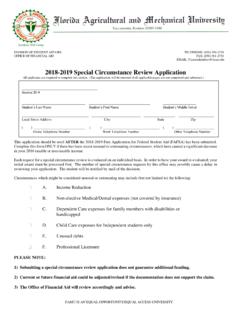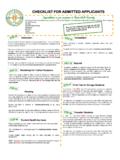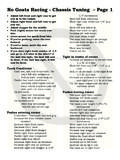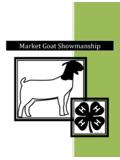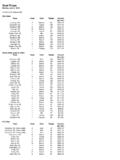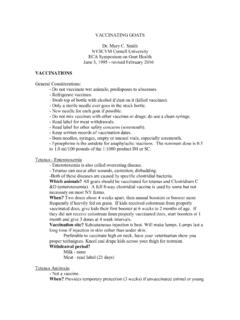Transcription of GETTING STARTED IN THE MEAT GOAT BUSINESS
1 Reproductive Management of Small Ruminants Angela McKenzie-Jakes and Dr. Lee Anderson GETTING STARTED IN THE MEAT goat BUSINESS Bulletin I, Vol. VIII Reproduction and Breeding Management of Goats and Sheep By Angela McKenzie-Jakes Extension Animal Science Specialist florida A&M university College of Engineering Sciences, Technology and Agriculture Research and Cooperative Extension Programs Reproductive Management of Small Ruminants Angela McKenzie-Jakes and Dr. Lee Anderson Introduction Reproduction and production efficiency is one of the most important economic traits in terms of livestock production.
2 Maintaining good reproductive functions in the herd or flock is pivotal to the success of any livestock production system. Productivity and profitability is measured by ovulation rate, conception rate, the number of kids or lambs born, the number of kids or lambs weaned and the frequency in which they are produced. Reproduction is the propagation and continuation of a species through a sequence of events. This process involves the production of hormones ( , estrogen, testosterone) and the development of the reproductive system to carry out germ cell development, fertilization, pregnancy and eventually parturition.
3 The Reproductive System of the Doe and Ewe The reproductive system of the doe and ewe consists of the ovaries, infundibulum (funnel), oviducts (fallopian tubes), uterine horns, uterine body, cervix, vagina and vulva. The ovaries are the primary organs of reproduction in the doe and ewe. The ovaries have two primary functions which are 1.) to produce ova (eggs) and 2.) to produce and secrete the female hormones estrogen and progesterone. The infundibulum directs the ovulated egg into the oviduct.
4 The oviduct is the site where fertilization (conception) and early embryonic development occurs. The uterine horn or body is where the conceptus grows and develops during gestation. The structure between the uterine body and vagina is the cervix which acts as a barrier to foreign material during pregnancy. Semen deposition may also occur here, or in the vagina which is the receptacle for the penis during mating and also an exit for urinary products.
5 The vulva is the external portion of the reproductive tract. The Doe The female goat is called a doe or nanny. When she is between the age of 6 to 12 months she is sometimes referred to as a doeling. The doe can reach puberty between 4 to 12 months of age. However, overfeeding or underfeeding the doe can hinder puberty as well as her reproductive performance. A lack of adequate nutrition will subsequently hinder lactation. Reproductive Management of Small Ruminants Angela McKenzie-Jakes and Dr.
6 Lee Anderson The genetic makeup of the animal also determines when puberty occurs in the female. Puberty is reach when the female exhibits her first heat and first ovulation. Estrus or heat is the period in which the doe will stand and allow the buck to breed her. This phase of the reproductive cycle may last between 12 to 36 hours (duration of heat). The period from one heat cycle to the next is referred to as the estrous cycle. In goats, the estrous cycle occurs every 18 to 24-days (21 days on average). Does that are in heat may exhibit signs of mucous discharge, swollen vulva, bleating, wagging their tail frequently and standing in heat which is a good indication that the doe is ready to mate.
7 The doe can be bred when she has reached at least 80 pounds of body weight or 60 to70% of the adult weight for her breed. Does that are bred to early may have difficulties during kidding (dystocia) or their future reproduction performance may be impaired. Following ovulation, the egg(s) is released from the ovary and is directed by the infundibulum (funnel-like structure) into the oviduct where fertilization occurs. The egg will remain viable for 12 to 24 hours after ovulation.
8 When the buck ejaculates, the sperm (viable for 48 hours after copulation) into the vagina they have to travel to the oviduct to fertilize the egg(s). The fertilized ova (embryo) travel to the uterus where it attaches to the uterine wall (implantation occurring 15 to 20 days after fertilization) for nourishment and removal of waste products throughout the duration of gestation (Wildeus, 2005). The gestation period of the doe ranges between 145 to 152 days (150 days on average); and under normal circumstances, the doe can have multiple births.
9 The Ewe The female sheep is referred to as the ewe or it may be called a yoe. At 1 to 2 years of age she may be referred to as a yearling regardless of whether she has lambed or not. In most cases, ewes reach puberty between 5 to 12 months of age. Like the doe, puberty is influenced by genetics and environment. However, ewe lambs born in the spring tend to reach puberty earlier than ewe lambs born in the fall. The reason is simple; spring lambs tend to have heavier body weights and are older than those born in the fall.
10 Another interesting fact is that ewe lambs that are born as singles, cycle earlier than ewe lambs born as twins or triplets and again this is because of their weight advantage. Single birth lambs are typically heavier at birth through weaning than multiple birth lambs. Other influences on puberty include feeding and breed-type. Like the doe, overfeeding and/or underfeeding the lamb at pre-weaning (period between birth and weaning) and post-weaning (period between weaning and slaughtering) can delay the onset of puberty.
